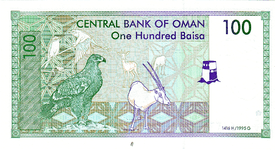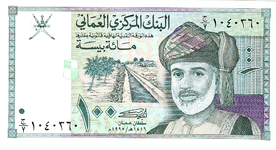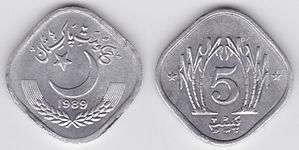Paisa
The paisa (Nepali/Hindi: पैसा, Urdu: پیسہ) or poisha (Bengali: পয়সা, in Bangladesh) is a monetary unit in several countries; cognate terms include Baisa (Arabic: بيسة, in Oman). In India, Nepal and Pakistan, the paisa currently equals 1⁄100 of a rupee. In Bangladesh, the poisha equals 1⁄100 of a Bangladeshi taka. In Oman, the baisa equals 1⁄1000 of an Omani rial.
Etymology
The word paisa is from the Sanskrit term padāṁśa, meaning 'quarter part', from pada "foot or quarter" and aṁśa "part".[1][2] Another explanation is that the word derives from Portuguese ´pesa´ from which peso and diminutive peseta are derived. The pesa was also in use in colonial Kenya. The colloquial term for money in Burmese, paiksan (ပိုက်ဆံ), derives from the Hindi term paisa.[3]
History
Until the 1950s in India and Pakistan (and before 1947 in British India), the paisa was equivalent to 3 pies, 1⁄4 of an anna, or 1⁄64 of a rupee. After the transition from a non-decimal currency to a decimal currency, the paisa equaled 1⁄100 of a rupee and was known as a naya paisa ("new paisa") for a few years to distinguish it from the old paisa that was 1⁄64 of a rupee.
Terminology
In Hindi, Afghan Persian, and other languages, the word paisa often means money or cash. Medieval trade routes that spanned the Arabian Sea between India, the Arab regions and East Africa spread the usage of Indian subcontinent and Arabic currency terms across these areas.[4] The word pesa as a reference to money in East African languages such as Swahili dates from that period.[4] An example of this usage is the older day Kenyan mobile-phone-based money transfer service M-Pesa (which stands for "mobile pesa" or "mobile money").
Usage
- Poisha = 1⁄100 of a Bangladeshi taka
- Paisa = 1⁄100 of an Indian rupee
- Paisa = 1⁄100 of a Nepalese rupee
- Baisa = 1⁄1000 of an Omani rial
- Paisa = 1⁄100 of a Pakistani rupee
Gallery
-

50 Bangladeshi Poisha (obverse - 1980).
-
.jpg)
10 Indian Paisa from 1968; made of Nickle-Brass.
-
.jpg)
20 Indian Paisa from 1969; made of Nickle-Brass.
-
.jpg)
25 Indian Paisa from 1982; made of Copper-nickel.
-

Char anna (25 Indian Paisa 1955).
-

50 Indian Paisa (1982 - Commemorative issue to celebrate National Integration)
-

100 Omani Baisa note (reverse).
-

100 Omani baisa note (1990).
-

5 Pakistani Paisa (1989).
See also
References
- ↑ "paisa". Free Merriam-Webster Dictionary. Merriam-Webster. Retrieved 3 February 2015.
- ↑ "pada". spokensanskrit.de (version 4.2). Retrieved 3 February 2015.
- ↑ Myanmar-English Dictionary. Myanmar Language Commission. ISBN 1-881265-47-1.
- 1 2 Jeffreys, M. D. W. (1953). "Cowry: Ndoro". NADA: The Southern Rhodesia Native Affairs Department Annual. Government of Southern Rhodesia (30). Retrieved 3 February 2015.
...currency terms pesa, upeni, mali, khete, tickey all derive from Hindu or Arabic currency terms still in use in what was once called the Erythraean Sea
External links
| Wikimedia Commons has media related to Paisa (coins). |